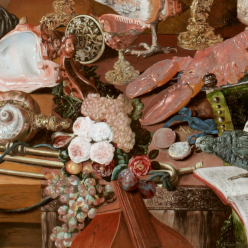
porcelain, glaze, cobalt.
Rijksmuseum, Amsterdam, inv. no. AK-RBK-15808-B
The klapmuts soup bowl was named after the broad-rimmed felt hats Dutch peasants traditionally wore during the Dutch Golden Age (c. 1600-1700). Artisans in the Chinese Ming and Qing dynasties produced klapmuts for Dutch markets. While the Chinese consumed their broth-like soup directly from the bowl, the Dutch were forbidden to lift their bowls during meals. The klapmuts’ shallow body and broad rim allowed European eaters to use a spoon. The Chinese imbued their carefully-crafted porcelain exports with Chinese symbolism, leading the Dutch to consider klapmuts objects of good fortune. Klapmuts were prized in the Netherlands as signs of cosmopolitan wealth.
Chinese artisans aspiring after shengong— divine worksmanship— produced klapmuts bowls. These delicate blue-and-white porcelain bowls had an ivory glaze and bore no trace of the potter’s hand. When blue-and-white pottery gained popularity in Europe, Chinese kilns became centers of unprecedented production. Chinese artisanship remained more than mere production; it was a way to honor the dynasty through artistic prowess. It was a significant source of dynastic pride to produce high-quality pottery on a large scale.
The Dutch East India Company (VOC) acquired klapmuts bowls through trade with China, marketing them in the Netherlands as “exotic” and “auspicious.” Chinese-produced klapmuts pervaded Dutch culture as status symbols, becoming staple pieces in still life paintings and aristocratic homes. The popularity of klapmuts bowls spurred Dutch reproductions of Chinese pottery. However, Delft-style klapmuts were not of the same caliber as Chinses klapmuts.
This particular bowl bears the “auspicious” image of a vase containing peacock feathers. Peacocks were the symbol of the Ming Dynasty, representing elegance and divine beauty. Peacock feathers served as status markers, as Chinese military and government officials wore peacock plumes in their hats. Members of the Chinese elite owned vases with small gaps to showcase the feathers’ fine quills. The “auspicious” image of peacock feathers was thus conflated with Chinese imperial power.
Furthermore, the image of a vase containing peacock feathers allowed artisans to demonstrate their superb technique. Klapmuts were fine pottery, and painting a vase with peacock feathers was an ambitious undertaking. The vase with peacock feathers enabled artisans to express their technical skills and honor their dynasty.
The klapmuts bowl is a remarkable emblem of an emerging global mindset in the early modern period. The Chinese tailored their products for a global market, accommodating Dutch cultural needs through the bowl’s design. Simultaneously, the Chinese asserted their imperial might by including “auspicious” images of peacock feathers. The production and artisanship behind the klapmuts bowls demonstrate a marked awareness of Dutch-Chinese interdependence on the global stage.
Sources:
Bowl (klapmuts) with flowering plants and auspicious objects. 1680-1720. Porcelain. Rijksmuseum, Amsterdam. October 12, 2018. https://www.rijksmuseum.nl/en/search/objects?q=klapmuts&p=5&ps=12&st=Objects&ii=5#/AK-RBK-15808-B,53.
Brook, Timothy. Vermeer’s Hat: The Seventeenth Century and the Dawn of the Global World. London: Bloomsbury Press, 2008.
Chow, Fong. “Symbolism in Chinese Porcelain: The Rockefeller Bequest.” Metmuseum.org. https://www.metmuseum.org/pubs/bulletins/1/pdf/3258464.pdf.bannered.pdf(accessed October 12, 2009).
Hay, Jonathan. Sensuous Surfaces: The Decorative Object in Early Modern China. Honolulu: University of Hawai`i Press, 2010.
Welch, Patricia Bjaaland. Chinese Art: A Guide to Motifs and Visual Imagery. Singapore: Tuttle Publishing, 2008.
